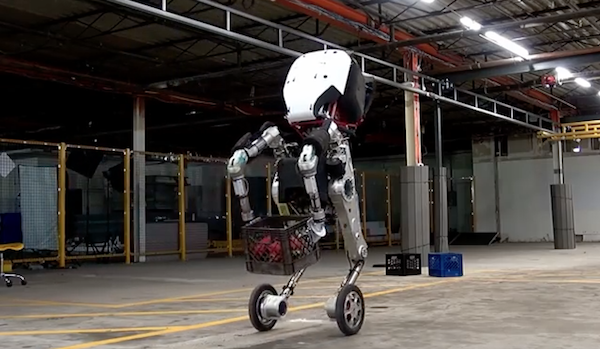
[Image above] Credit: Boston Dynamics; YouTube
If you weren’t one of the 5 million-plus viewers who watched Handle, the latest robot from Google-owned Boston Dynamics, perform like a human, I’ll wait.
Credit: Boston Dynamics; YouTube
Standing 6’6” tall on two wheels, Handle pirouettes, jumps over obstacles and onto tables, lifts 100 lbs. (or more), and descends stairs and snow-covered hills. However, it’s still a research project—Handle is not yet ready for prime time.
But when it IS ready, can it go to work?
There is a growing concern among many workers that robots will replace their jobs, especially those in the manufacturing sector.
Using robotics to automate systems is one way to improve processes. Ever since the Industrial Revolution, companies have endeavored to streamline their manufacturing processes through automation, making it possible for us consumers to enjoy lower prices on goods and services.
In 1913, Henry Ford launched the first auto assembly line, making cars affordable for everyone. Are you old enough to remember when we first pumped our own gas?
Most of us probably do remember when ATMs starting making it easy for us to access our money. And just a few years ago, researchers experimented with flying robots—now, drones are improving processes in government and the corporate world.
So, are robots going to take over our jobs?
Global industries are embracing robots, especially those in the electronics, metals, chemical, plastics, and rubber sectors. In 2015, robot sales worldwide increased by 15% to 253,748 units, with China having the biggest market share with 27% of the total supply, according to a report from the International Federation of Robotics.
Findings from a McKinsey & Co. report suggest less than 5% of occupations are candidates for full automation. But nearly every occupation has the potential to become partially automated—nearly half of activities employees are paid to do in the world’s workforce. The report states that work activities most likely to be automated are physical activities performed in retail and manufacturing, as well as collecting, sifting through, and processing data.
In a recent Washington Post article, Michael Jones, author and assistant professor of economics at the University of Cincinnati, says that although job loss in some occupations will continue, it will be offset by gains in other fields. He describes the case of a supercomputers assisting physicians at the Cleveland Clinic to diagnose and treat patients more efficiently.
If Handle were for hire, it could perform tasks such as lifting and moving heavy objects, perhaps eliminating worker’s comp claims. What about search and rescue missions where robots could more quickly climb and reach into inaccessible spaces? The possibilities for robots to replace some of the more difficult human physical activities are endless.
Of course, robots will not replace all human activity. There will always be a need for people to perform the “brain work”—tasks such as analyzing data, problem-solving, and decision-making, among other cognitive functions (or can robots do that, too?). And as products and services continue to improve as a result, we consumers will ultimately benefit.
